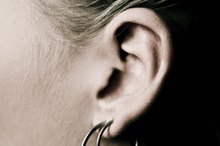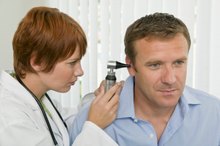What does fact checked mean?
At Healthfully, we strive to deliver objective content that is accurate and up-to-date. Our team periodically reviews articles in order to ensure content quality. The sources cited below consist of evidence from peer-reviewed journals, prominent medical organizations, academic associations, and government data.
The information contained on this site is for informational purposes only, and should not be used as a substitute for the advice of a professional health care provider. Please check with the appropriate physician regarding health questions and concerns. Although we strive to deliver accurate and up-to-date information, no guarantee to that effect is made.
Sore on Tip of Ear Won't Heal
Because your ear protects the mechanisms by which you hear, any wound or sore can be cause for concern, especially when it does not heal. A sore on the tip of the ear is not always cause for concern, but can be disturbed more than other places on the ear if you wear glasses, put your hair behind your ear or have a nervous habit of picking at your ear. If you try healing methods, yet the sore still does not heal, it might be time to call your physician.
The Basics
Your ear is made of elastic cartilage, a flexible, tough material that does not have a lot of blood vessels compared with other areas of your skin. This means your ear has a higher tolerance for pain, which is why piercing the ear doesn’t hurt as much as other areas. To heal, your blood vessels must carry new blood and oxygen to the ear. Because the ear doesn’t have as many vessels, it’s not unusual to find that a sore heals more slowly, according to website Head and Face Medicine 1.
- Your ear is made of elastic cartilage, a flexible, tough material that does not have a lot of blood vessels compared with other areas of your skin.
- Because the ear doesn’t have as many vessels, it’s not unusual to find that a sore heals more slowly, according to website Head and Face Medicine 1.
Lifestyle
Why Are My Pierced Ears Sore?
Learn More
When a sore on your ear has been slow to heal, it’s important to evaluate the lifestyle factors that could be affecting healing time. If you have a habit of picking at or disturbing the sore, you might have to make a special effort not to disturb the sore to allow for healing. You also might be unconsciously picking at the sore as you sleep, which might require you to wear protective gloves or mittens while you sleep to prevent scratching. Another factor that affects healing is your diet. Your body needs substances such as protein to repair a sore. If you do not get enough nutrients to support healthy cell growth, the sore on your ear might stick around a little longer.
- When a sore on your ear has been slow to heal, it’s important to evaluate the lifestyle factors that could be affecting healing time.
See Your Physician
If you have had the sore on your outer ear for more than four weeks with no signs of healing, it might be time to call your physician. After taking a look at your ear, your physician can recommend further testing or special wound-healing treatments, such as therapies to stimulate blood flow to your ears.
Extreme Circumstances
Earaches and Cycling
Learn More
When you experience a sore on the tip of your ear, think back to where you got the sore -- curling-iron burns or the after-effects of a sunburn’s peeling skin are two examples. However, if the sore showed up on its own, this could indicate a potential cause for concern. Because the tip of the ear is where the sun hits your ear, it’s possible the sore could be the result of a skin cancer. See your physician if you cannot remember the source of the injury, and it has not been healing.
- When you experience a sore on the tip of your ear, think back to where you got the sore -- curling-iron burns or the after-effects of a sunburn’s peeling skin are two examples.
Related Articles
References
- Head and Face Medicine: Cutaneous Lesions of the External Ear
- National Cancer Institute: Head and Neck Cancer -- Questions and Answers
- New York-Presbyterian: Cuts and Wounds of the External Ear
- Stead W, Aronson M, Bond S. Patient education: Sore throat in adults (Beyond the Basics). UpToDate. Jun 3, 2019.
- Sore Throats. American Academy of Otolaryngology-Head and Neck Surgery. http://www.entnet.org/content/sore-throats.
- Stead W. Patient Education: Sore Throat in Adults (Beyond the Basics). UpToDate. https://www.uptodate.com/contents/sore-throat-in-adults-beyond-the-basics#H5.
- Parmet S, Lynm C, Glass RM. JAMA patient page. Sore throat. JAMA. 2004;291(13):1664. doi:10.1001/jama.291.13.1664
- Stead W, Aronson M, Bond S. Patient education: Sore throat in adults (Beyond the Basics). Jun 3, 2019.
- Renner B, Mueller CA, Shephard A. Environmental and non-infectious factors in the aetiology of pharyngitis (sore throat). Inflamm Res. 2012;61(10):1041-52. doi:10.1007/s00011-012-0540-9
- Sore Throats. American Academy of Otolaryngology-Head and Neck Surgery.
- Pelucchi C, Grigoryan L, Galeone C, et al. Guideline for the Management of Acute Sore Throat. Clinical Microbiology and Infection. 2012;18:1-27. doi:10.1111/j.1469-0691.2012.03766.x.
- Stead W. Patient Education: Sore Throat in Adults (Beyond the Basics).
Writer Bio
Rachel Nall began writing in 2003. She is a former managing editor for custom health publications, including physician journals. She has written for The Associated Press and "Jezebel," "Charleston," "Chatter" and "Reach" magazines. Nall is currently pursuing her Bachelor of Science in Nursing at the University of Tennessee.








